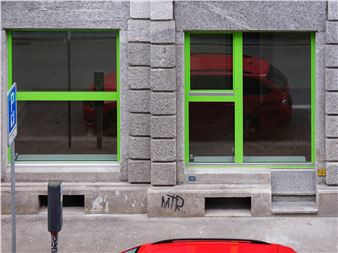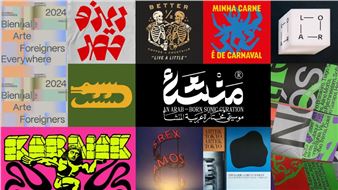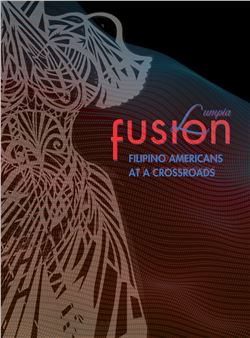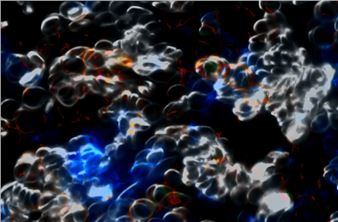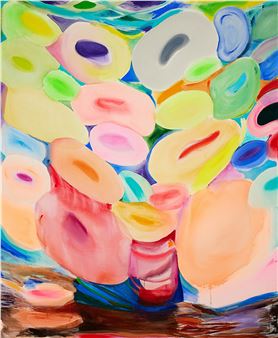Cansu і§Г¶ІФіҫұріъ & TuДҹba ГҮДұnar: On the Border
Pg Basement presents its first exhibition, вҖңOn the BorderвҖқ, a collaboration bringing together two young Turkish artists, Cansu і§Г¶ІФіҫұріъ and TuДҹba ГҮДұnar, exploring a set of relations between public architecture, the life of the community and the role of life/death. Taking as a starting point the modern architectural history of Istanbul with its endless cycles of amnesia and destruction, the artists are looking at the ways in which urban transformations (from suburban to urban, gentrification to corporatization, public to private) are also transformations of memory: The violence of demolition as a permanent condition - the city has been under demolition and construction for centuries - obscures the possibility of being at home, and erodes a civic society seen therefore as impermanent and temporary. A change in memory is lost to time when it is not documented to be remembered; it becomes a space of forgetfulness.
At what point do buildings in a city begin to resemble the erasure of personal memory? At what point is the violence inflicted on people also translated on architectural forms of exclusion and force? The history of public traumatic memory begins always in the social and physical fabric of cities; built history can be physically removed only once memory has been effectively obliterated. Accordingly, the artists are searching in their practice for memory check points that enable them to document memory together with its interruption. і§Г¶ІФіҫұріъ and ГҮДұnar examine here the amnesic space of the city, informed by the use of the вҖҳborderвҖҷ metaphor in Zeynep SayДұnвҖҷs seminal book вҖңГ–lГјm TerbiyesiвҖқ (2018): The border is a metaphor for an individual encounter between identity and memory, which is interrupted when both identity and memory are no longer private, but instead, tools of centralized authority to exert control over human agency.
Nevertheless, architecture is always part building, and part paradox: In Istanbul it has often been a tool of both power and powerlessness: It has served to mark borders and establish dominant ideologies (Byzantine, Ottoman and Republican) but it has also been used by people (rather unknowingly) in order to contest authority, and create temporary islands of political freedom, inside an authoritarian landscape; social movements always occupy architectural bodies that politicize space. Through her material deconstructions in concrete that aim to simulate the role of architecture as a tool of emancipation, Cansu і§Г¶ІФіҫұріъ reinterpreted the chaos of the urban space as a non-linear rearrangement of the social sphere. TuДҹba ГҮДұnar, on the other hand, through the image of the headless tree, reinforces the metaphor of headlessness as the image of an impossible community; without memory or identity of their own, individuals remain anonymous and alienated.
вҖңOn the BorderвҖқ is a portrayal of dystopia, from the vantage point of the dispossessed, treating para-architecture as a social phenomenon. In the dialogue between the two artists, the border is about a singularity event: How is it possible to live, and even to die, in a situation in which the basic mechanisms - memory and identity - that regulate the possibilities of existence, are pushed to a borderline? Living in spaces of active forgetfulness, means that the weight of history is always a weak force, therefore artists turn to fragile markers (signs, places, sights) in order to conjure up their vision of what it means to co-exist with disjointed time. In their current practice, і§Г¶ІФіҫұріъ and ГҮДұnar conceive of their work as an intervention bringing together strategies from urban survival, socio-political analysis and aesthetic re-interpretations of the broken memory-space continuum. The exhibition was curated by Arie Amaya-Akkermans.
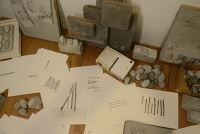
Recommended for you
Pg Basement presents its first exhibition, вҖңOn the BorderвҖқ, a collaboration bringing together two young Turkish artists, Cansu і§Г¶ІФіҫұріъ and TuДҹba ГҮДұnar, exploring a set of relations between public architecture, the life of the community and the role of life/death. Taking as a starting point the modern architectural history of Istanbul with its endless cycles of amnesia and destruction, the artists are looking at the ways in which urban transformations (from suburban to urban, gentrification to corporatization, public to private) are also transformations of memory: The violence of demolition as a permanent condition - the city has been under demolition and construction for centuries - obscures the possibility of being at home, and erodes a civic society seen therefore as impermanent and temporary. A change in memory is lost to time when it is not documented to be remembered; it becomes a space of forgetfulness.
At what point do buildings in a city begin to resemble the erasure of personal memory? At what point is the violence inflicted on people also translated on architectural forms of exclusion and force? The history of public traumatic memory begins always in the social and physical fabric of cities; built history can be physically removed only once memory has been effectively obliterated. Accordingly, the artists are searching in their practice for memory check points that enable them to document memory together with its interruption. і§Г¶ІФіҫұріъ and ГҮДұnar examine here the amnesic space of the city, informed by the use of the вҖҳborderвҖҷ metaphor in Zeynep SayДұnвҖҷs seminal book вҖңГ–lГјm TerbiyesiвҖқ (2018): The border is a metaphor for an individual encounter between identity and memory, which is interrupted when both identity and memory are no longer private, but instead, tools of centralized authority to exert control over human agency.
Nevertheless, architecture is always part building, and part paradox: In Istanbul it has often been a tool of both power and powerlessness: It has served to mark borders and establish dominant ideologies (Byzantine, Ottoman and Republican) but it has also been used by people (rather unknowingly) in order to contest authority, and create temporary islands of political freedom, inside an authoritarian landscape; social movements always occupy architectural bodies that politicize space. Through her material deconstructions in concrete that aim to simulate the role of architecture as a tool of emancipation, Cansu і§Г¶ІФіҫұріъ reinterpreted the chaos of the urban space as a non-linear rearrangement of the social sphere. TuДҹba ГҮДұnar, on the other hand, through the image of the headless tree, reinforces the metaphor of headlessness as the image of an impossible community; without memory or identity of their own, individuals remain anonymous and alienated.
вҖңOn the BorderвҖқ is a portrayal of dystopia, from the vantage point of the dispossessed, treating para-architecture as a social phenomenon. In the dialogue between the two artists, the border is about a singularity event: How is it possible to live, and even to die, in a situation in which the basic mechanisms - memory and identity - that regulate the possibilities of existence, are pushed to a borderline? Living in spaces of active forgetfulness, means that the weight of history is always a weak force, therefore artists turn to fragile markers (signs, places, sights) in order to conjure up their vision of what it means to co-exist with disjointed time. In their current practice, і§Г¶ІФіҫұріъ and ГҮДұnar conceive of their work as an intervention bringing together strategies from urban survival, socio-political analysis and aesthetic re-interpretations of the broken memory-space continuum. The exhibition was curated by Arie Amaya-Akkermans.
Artists on show
Contact details


 ARTISTS
ARTISTS







